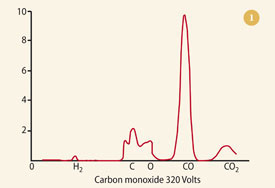
Thomson was, however, dissatisfied with his photographic method of recording the parabolas. The problem was that lightweight species penetrated the film deeply, causing a disproportionate amount of blackening, compared to heavier ions, and thus quantitative estimations of beam intensities were impossible.
He eventually solved this problem by constructing a slit in the tube where the photographic film would normally sit. Behind this slit was a Faraday cup that collected any ion charge. The intensity of the charge was estimated by noting the time it took for a charged electroscope to discharge. By slowly changing the magnetic field, the ion beams could be positioned, one at a time, on the slit, and their intensities noted. From his results he plotted intensity against relative mass: Thomson had invented the world's first scanning mass spectrometer.
8
Leaving his protégé, Francis William Aston, to concentrate on determining the isotopic constitution of any elements he had to hand, Thomson decided to record the mass spectra of some chemical compounds, including slightly impure CO, HCl and carbonyl chloride (COCl
2). The first of these is shown in
Fig 1.
8 Note the abundant peak of the undissociated molecule, together with the smaller peaks at 12 (carbon) and 16 (oxygen) - an astonishingly good match with today's bar-graph version (see
Fig 2). The spectra of these species represented the conclusion of Thomson's work with positive rays and mass spectrometry. Administration (as master of Trinity College, Cambridge, from 1918) took the place of bench-work.
However, he published, initially in 1913, his thoughts on the potential of his technique to chemical analysis.
9 These he amplified in his 1921 book
Rays of positive electricity and their application to chemical analyses.
We can, by measuring the parabolas, determine the masses of all the particles in the [discharge] tube, and thuidentify the contents of the tube as far as this can be done by a knowledge of the atomic and molecular weights of all its constituents. When we find a new line we know at once the atomic or molecular weight of the particle that produced it.
[In conventional forms of spectroscopy] the presence of one gas is apt to swamp the spectrum of another.This is not the case to anything like the same extent with the positive rays; the presence of other gases is a matter of comparatively little importance.
The method is more sensitive than that of [other forms of] spectrum analysis. With. [my] apparatus the helium in 1 cm
3 of air [
ie, about 3 x 10
-6 cm
3] could be detected with great ease.

No comments:
Post a Comment